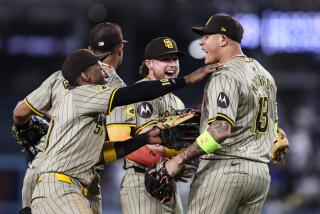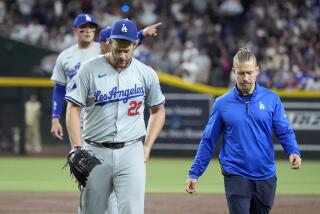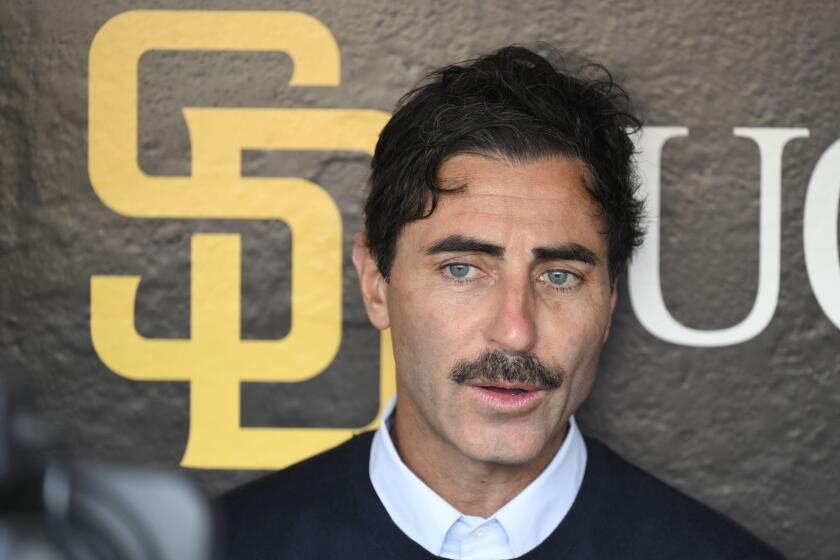Stadium Revamp Is Fair Game
A few months into his new job as the Dodgers’ general manager, comfortable with his assessment of the home-field advantage at Dodger Stadium and which players might benefit most from it, Paul DePodesta got a message from his boss.
Hoping to boost revenue by at least $15 million each season, owner Frank McCourt planned to install hundreds of high-priced seats in some of Dodger Stadium’s expansive foul ground. DePodesta checked the blueprints, did some quick analyses, made sure the field dimensions would not be altered and reported to McCourt: Dodger Stadium still would be a pitchers’ park.
“As soon as I knew we weren’t affecting the fair territory or the outfield wall or anything like that, I knew to some degree it was going to limit the overall effect that it had,” DePodesta said of the restructuring. “There wasn’t anything from a baseball standpoint that was disagreeable.”
DePodesta solicited input from coaches and players on what they might like included in the new dugout. He applauded the addition of a dirt warning track to replace a rubberized one, on which players must wear special cleats or risk slipping and falling, as J.T. Snow of the San Francisco Giants did at Angel Stadium during the 2002 World Series. (The Angels also have replaced their rubberized track with a dirt one.)
The Dodgers have added 1,600 seats at field level, most of which have been sold, according to a Dodger spokesman. Gary Miereanu, vice president of communications, said “almost all” of the dugout seats were gone and that 75% of the baseline seats had been sold. For prices up to $400 a game, fans in those seats will take home souvenirs that would have been foul outs last year.
To accommodate those seats, the Dodgers have reduced foul ground from 30,000 square feet to 20,000, said Howard Sunkin, senior vice president of public affairs.
“The plan was to be in the same vicinity with the new ballparks in terms of foul territory,” McCourt said.
DePodesta said his analysis was more theoretical than statistical: Some foul balls no longer will become outs, so pitchers will throw a few more pitches and some batters who would have fouled out will reach base.
“It’s going to be the same for the guys on the other side of the field too,” he said. “So, in terms of wins and losses, it should have no impact, because we’re all playing the same game. But it probably will increase batting average slightly and run scoring slightly.”
The Dodgers could not conduct a detailed statistical evaluation, he said, because they do not chart where foul balls land. They keep track of where balls land in fair territory so they can determine patterns among pitchers and hitters and can move fielders accordingly.
“Balls in foul territory don’t affect how you position your players,” DePodesta said.
“You don’t have to be terribly precise when you’re charting that -- just, ‘Hey, that was a foul pop and that was an out.’ So it was hard to really distinguish, ‘Well, that particular one probably would have been in the stands.’ ”
On his website, the Fourth Outfielder, statistician-writer Tom Meagher says there were 906 foul outs at Dodger Stadium over the last six seasons, excepting interleague play -- an average of 2.1 a game, roughly one a team.
Based on that one-third reduction of foul territory, Meagher said, a team’s pitchers will throw about one extra pitch a game, and a team will score one extra run roughly every 11.5 games -- about seven more runs over an 81-game home schedule.
Without looking at any statistics, Dodger catcher David Ross agreed that the effect would be minimal.
“It may be five or six balls in foul ground,” he said. “I don’t think there’s that many outs made in that area. The pitchers’ park is more because of the heavy air at night in L.A. During the day, a ball flies. At night, it doesn’t come close to going out.”
Derek Lowe is represented by Scott Boras, who takes the tiniest detail into consideration when advising free-agent clients where to sign. Lowe, who signed a $36-million contract with the Dodgers, said he and Boras never discussed the reduction in foul territory.
“If you go into a season banking on getting foul-ball outs, you’re probably not focused on the right thing,” Lowe said.
Lowe is a ground-ball pitcher, less prone to inducing foul pop-ups. However, DePodesta said the renovation had not influenced any personnel moves, including signing Lowe.
“It turns out, we still have a lot of ground-ball pitchers on our staff, but that wasn’t a result of this happening at all,” DePodesta said. “I still expect Dodger Stadium to be a good pitchers’ park. Brad Penny is a fly-ball guy, and I think it’s still going to be a good place for him to pitch.”
*
(BEGIN TEXT OF INFOBOX)
NEW SEATS
* Added: 1,600 seats; 300 behind home plate, 650 down foul lines.
* Prices: $275-$400 per seat for Dugout Club; $40-$125 for field box seats.
More to Read
Are you a true-blue fan?
Get our Dodgers Dugout newsletter for insights, news and much more.
You may occasionally receive promotional content from the Los Angeles Times.











